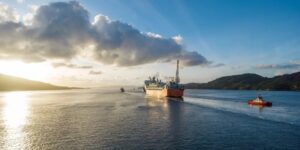After years of upgrades, Norwegian field back on stream
The Njord field in the Norwegian Sea has commenced production again, following an extensive six-year upgrade of the platform and the floating storage and offloading vessel (FSO).


Production from the Njord field resumed at 16:30 on 27 December, extending the planned field life for another 20 years.
Coming on stream in 1997, the installations were initially designed to remain in operation until 2013, but there were large volumes left in the ground, in addition to discoveries nearby that can be produced and exported via Njord, Equinor said.
The platform and FSO were brought ashore in 2016 after 19 years of production. The Njord A platform was upgraded at Stord, where it was constructed in the 1990s, while the Njord Bravo FSO was inspected prior to the upgrade and prepared for tow-out in Kristiansund and underwent refurbishment in Haugesund.
“This is the first time a platform and an FSO have been disconnected from the field, upgraded, and towed back, and we have now doubled the field’s life. It has been a big and challenging job, partly performed during a pandemic, and I want to thank everyone who has contributed. The Njord field will now deliver important volumes to the market for another two decades,” said Geir Tungesvik, Equinor’s Executive Vice President for Projects, Drilling & Procurement.
Related Article
According to Equinor, ten new wells will be drilled from an upgraded drilling facility, new discoveries have been made at the outer edges of Njord, and more exploration will be carried out in the surrounding area.
In addition, the platform and FSO have been prepared to receive production from two new subsea fields, Bauge and Fenja, with a total of 110 million barrels of recoverable resources.
The project is said to have a Norwegian content of more than 90 per cent. Aker Solutions was in charge of the platform engineering and upgrading, while Brevik Engineering carried out the engineering work for the FSO, which was upgraded by Aibel.
Production from the Njord field was initially supposed to resume two years ago. However, the upgrading project was more challenging than expected and was hit by the pandemic, Equinor said, adding that this has also put upward pressure on costs. Capital expenditures total just over NOK 31 billion (€2.96 billion), compared with the original NOK 17 billion in the plan for development and operation.
Related Article
The plan is to have the Njord field in a few years receiving power from shore via the Draugen platform and be partially electrified, which is expected to reduce the annual CO2 emissions by about 130,000 tonnes.
“Our ambition is to produce about the same volume from Njord and Hyme as we have produced so far, more than 250 million barrels of oil equivalent,” said Kjetil Hove, Equinor’s Executive Vice President for Exploration & Production Norway.
Njord was originally an oil field, discovered in 1986 and began production in 1997, with gas exports only starting in 2007. The majority of the future production from the field will be gas.
Produced oil is transported by pipeline to the Njord Bravo FSO, and onwards by tankers to the market. Gas from the field is exported through a 40-kilometer pipeline connected to the Åsgard transportation system (ÅTS), and from there to the Kårstø terminal.
The Njord licensees are Wintershall Dea Norge (50 per cent), Equinor Energy (27.5 per cent, operator) and Neptune Energy Norge (22.5 per cent).








